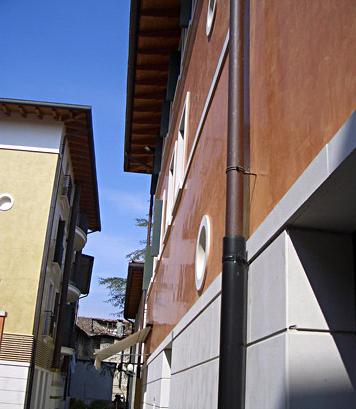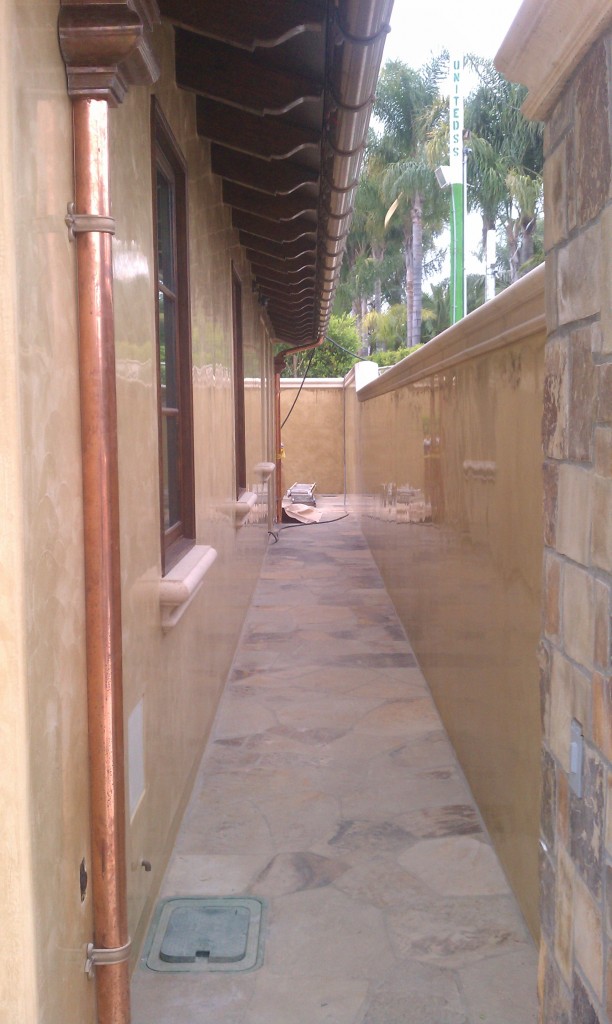—Synonyms Venetian Stucco, Marmorino, Italian Stucco, Stucco Veneziano
What is it?

Italian Building Exterior with “Authentic” Venetian Plaster: “The first questions to ask of any product claiming to be “Venetian Plaster” is, “Can it be applied on exteriors?” and “Is it composed of aged slaked lime?”
Venetian plaster is a beautiful and historic product that has been used throughout Italy for centuries. In Italy it is sometimes referred to as “Marmorino” meaning “little marble” due to the fact that it contains Carrara marble chips. Venetian plaster was often applied to resemble the appearance of polished marble or honed limestone.
Historic recipes consisted of aged slaked lime, coarse or finely ground marble dust, small amounts of raw linseed oil and in some instances soap. Modern variations, that try not to stray to far from the traditional recipes include some silica sand, rheologic modifiers and binders.
What it is not:
Don’t be fooled: “Authentic” Venetian Plaster is not tinted joint compound, tinted gypsum plaster or tinted Portland plaster. That includes any product sold and mixed from a dry state and most products sold in one gallon paint cans at hardware stores such as Lowes or Home Depot.
Generic marketing: In the same way marketers misuse the name “Burgundy”; which represents the most prestigious wines in the world, “Venetian Plaster” has become a term loosely used to represent virtually any troweled on decorative finish. The truth is that most products represented as Venetian plaster should be more accurately referred to as decorative or faux finishes. That even includes synthetic finishes referred to as “stucco lustro” imported from Italy. Although these could be referred to as “Authentic Italian Finishes” they should not to be confused with the natural slaked lime product. I have seen numerous cases where homeowners with high end homes insist they got Venetian plaster when in fact the contractor sold them a domestically manufactured product applied by a drywall contractor. Although many of these products produce fine results, there is a difference between real Venetian plaster and “Faux” Venetian Plaster.
How do you know if you are getting the real thing? The first questions to ask of any product represented as “Venetian Plaster” is “Can it be applied on exteriors?” and “Is it composed of aged slaked lime?” The reason being; that all true Venetian Plasters can be (and are) applied to both the interiors and exteriors of buildings in Italy. Additionally all true Venetian Plasters are made of at least 2yr old slaked lime putty and come pre-mixed in buckets not bags.
Modern Uses:
Authentic lime based Venetian plaster is still produced and used in Italy and other countries in Europe. In the last several years it has gained popularity causing the name “Venetian Plaster” to be exploited by knock off products that try to imitate its “old world” appearance.
As mentioned authentic “lime based” Venetian plaster can be used on interiors and exteriors as a decorative finish over a conventional drywall or (in the case of exterior applications) stucco. This is commonly done over both existing interior drywall walls and stucco exteriors with excellent results. In some cases cracks need to be treated and the existing finish may need special base coats before the application of the Venetian product.
Precautions
Although an “old world” look is preferred by some, staining can result from water leaching through cracks as from water running down walls where no over-hangs are present such as balconies or block wall caps. Water staining is reduced if the plaster is protected for 48 to 72 hours allowing the “carbonation” process to take place.
In conclusion authentic Venetian Plaster is beautiful, durable, natural, timeless and ages gracefully. Applied to a homes exterior it creates a stunning appearance and does not need to be maintained and “modernized” like paint or stucco. However before you choose a Venetian Plaster, ask about the product, take an opportunity to look at some existing work where it was used, and finally make sure you know what you are buying.

